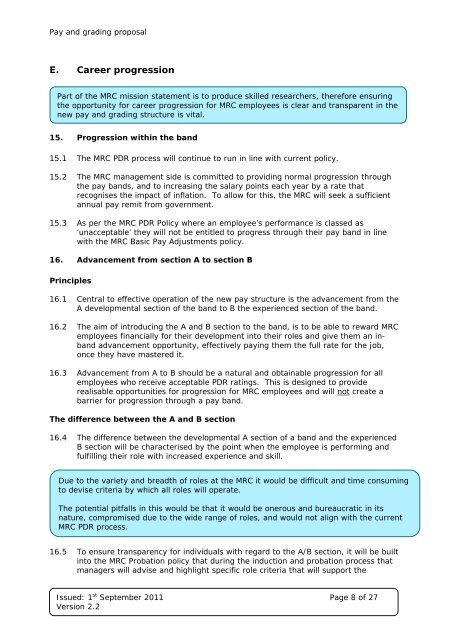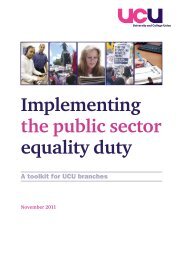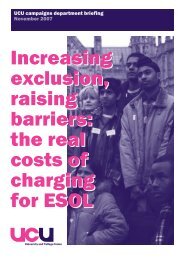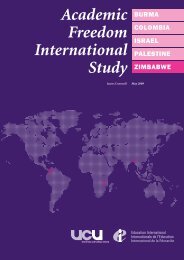MRC pay and grading structure - UCU
MRC pay and grading structure - UCU
MRC pay and grading structure - UCU
Create successful ePaper yourself
Turn your PDF publications into a flip-book with our unique Google optimized e-Paper software.
Pay <strong>and</strong> <strong>grading</strong> proposalE. Career progressionPart of the <strong>MRC</strong> mission statement is to produce skilled researchers, therefore ensuringthe opportunity for career progression for <strong>MRC</strong> employees is clear <strong>and</strong> transparent in thenew <strong>pay</strong> <strong>and</strong> <strong>grading</strong> <strong>structure</strong> is vital.15. Progression within the b<strong>and</strong>15.1 The <strong>MRC</strong> PDR process will continue to run in line with current policy.15.2 The <strong>MRC</strong> management side is committed to providing normal progression throughthe <strong>pay</strong> b<strong>and</strong>s, <strong>and</strong> to increasing the salary points each year by a rate thatrecognises the impact of inflation. To allow for this, the <strong>MRC</strong> will seek a sufficientannual <strong>pay</strong> remit from government.15.3 As per the <strong>MRC</strong> PDR Policy where an employee’s performance is classed as‘unacceptable’ they will not be entitled to progress through their <strong>pay</strong> b<strong>and</strong> in linewith the <strong>MRC</strong> Basic Pay Adjustments policy.16. Advancement from section A to section BPrinciples16.1 Central to effective operation of the new <strong>pay</strong> <strong>structure</strong> is the advancement from theA developmental section of the b<strong>and</strong> to B the experienced section of the b<strong>and</strong>.16.2 The aim of introducing the A <strong>and</strong> B section to the b<strong>and</strong>, is to be able to reward <strong>MRC</strong>employees financially for their development into their roles <strong>and</strong> give them an inb<strong>and</strong>advancement opportunity, effectively <strong>pay</strong>ing them the full rate for the job,once they have mastered it.16.3 Advancement from A to B should be a natural <strong>and</strong> obtainable progression for allemployees who receive acceptable PDR ratings. This is designed to providerealisable opportunities for progression for <strong>MRC</strong> employees <strong>and</strong> will not create abarrier for progression through a <strong>pay</strong> b<strong>and</strong>.The difference between the A <strong>and</strong> B section16.4 The difference between the developmental A section of a b<strong>and</strong> <strong>and</strong> the experiencedB section will be characterised by the point when the employee is performing <strong>and</strong>fulfilling their role with increased experience <strong>and</strong> skill.Due to the variety <strong>and</strong> breadth of roles at the <strong>MRC</strong> it would be difficult <strong>and</strong> time consumingto devise criteria by which all roles will operate.The potential pitfalls in this would be that it would be onerous <strong>and</strong> bureaucratic in itsnature, compromised due to the wide range of roles, <strong>and</strong> would not align with the current<strong>MRC</strong> PDR process.16.5 To ensure transparency for individuals with regard to the A/B section, it will be builtinto the <strong>MRC</strong> Probation policy that during the induction <strong>and</strong> probation process thatmanagers will advise <strong>and</strong> highlight specific role criteria that will support theIssued: 1 st September 2011 Page 8 of 27Version 2.2






![(.pdf) [29kb] - UCU](https://img.yumpu.com/50914942/1/184x260/pdf-29kb-ucu.jpg?quality=85)









